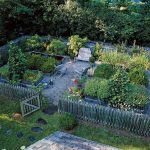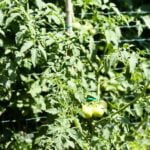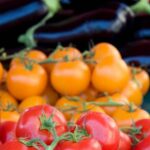Are you considering starting your own vegetable and fruit gardens? There are numerous benefits to growing your own produce, from the satisfaction of nurturing plants from seed to harvest, to the health and environmental benefits of consuming organic, home-grown produce. In this article, we will explore the advantages of having a vegetable and fruit garden, as well as provide tips and guidance on planning, planting, and maintaining a successful garden.
Whether you have a spacious backyard or just a small balcony, cultivating your own vegetable and fruit gardens can be a rewarding and enjoyable experience. Not only does it offer the convenience of having fresh produce at your fingertips, but it also promotes sustainable living by reducing food miles. Additionally, growing your own fruits and vegetables allows you to have complete control over what goes into your food, ensuring that it is free from harmful chemicals and pesticides.
In the following sections, we will cover essential aspects of vegetable and fruit gardening such as location selection, soil preparation, crop selection for beginners, planting techniques, maintenance practices like watering and pest control. Furthermore, we will discuss troubleshooting common issues that may arise in your garden while also exploring eco-friendly practices such as composting and organic gardening methods. Join us in exploring the wonderful world of vegetable and fruit gardening.
Planning Your Vegetable and Fruit Garden
Choosing the Right Location
When planning your vegetable and fruit garden, it’s important to choose the right location for optimal growth. Look for a spot that receives plenty of sunlight, as most vegetables and fruits require at least 6-8 hours of direct sunlight per day. Additionally, consider access to water and airflow to ensure proper hydration and ventilation for your plants.
Soil Quality and Preparation
Before you start planting, assess the quality of your soil. Most vegetables and fruits thrive in well-drained soil with a pH level between 6.0 to 7.0. If your soil is lacking in nutrients or has poor drainage, consider adding compost or organic matter to improve its quality. Conducting a soil test can also help determine the specific needs of your garden.
Climate Considerations
It’s crucial to consider the climate in your area when choosing which vegetables and fruits to grow. Some crops are more suited for cooler temperatures, while others require warmer conditions. Research which plants are best suited for your climate zone and plan your garden accordingly. Additionally, consider factors such as frost dates and growing seasons to ensure a successful harvest.
By carefully considering these location, soil, and climate considerations when planning your vegetable and fruit garden, you can set yourself up for a successful and bountiful harvest. Remember that each plant has its own unique requirements, so take the time to research and prepare accordingly for the best results in your garden.
Choosing the Right Vegetables and Fruits for Your Garden
When starting a vegetable and fruit garden, it’s important to choose the right plants that will thrive in your specific location and climate. Whether you have limited space or are new to gardening, there are plenty of options to consider when selecting which fruits and vegetables to grow. In this section, we will explore some tips for beginners on how to choose the right vegetables and fruits for your garden.
Consider Your Climate and Growing Season
Before selecting which vegetables and fruits to plant, it’s essential to consider your climate and the length of your growing season. Some plants thrive in cooler temperatures, while others require plenty of sunlight and warmth. Researching which crops are best suited for your specific climate can help ensure a successful harvest.
Start With Easy-to-Grow Varieties
For beginners, it’s advisable to start with easy-to-grow varieties of vegetables and fruits. Some great options for beginners include tomatoes, peppers, zucchini, lettuce, strawberries, and herbs such as basil and mint. These plants are relatively low-maintenance and can be forgiving to new gardeners who are still learning the ropes.
Consider Your Space Limitations
If you have limited space for your vegetable and fruit garden, consider compact or dwarf varieties of plants that can thrive in containers or small raised beds. Options like cherry tomatoes, dwarf cucumber varieties, and patio-sized berry bushes can be perfect for small gardens or even balcony spaces.
By carefully considering these tips when choosing your vegetables and fruits for your garden, you can set yourself up for a successful growing season. With the right planning and selection of plants that suit your space and climate, you’ll be well on your way to enjoying a bountiful harvest from your very own vegetable and fruit gardens.
Preparing the Soil and Planting Your Vegetable and Fruit Garden
When it comes to preparing the soil and planting your vegetable and fruit garden, there are some important steps to consider to ensure a successful harvest. The first step is to test the pH of your soil to determine if any adjustments need to be made before planting.
Most vegetables and fruits thrive in slightly acidic soil with a pH between 6 and 7. Additionally, make sure that your soil has good drainage to prevent water-logging, which can lead to root rot.
Once you have prepared your soil, it’s time to plant your chosen vegetables and fruits. Consider the spacing requirements for each type of plant, as crowding can lead to poor growth and increased susceptibility to disease. It’s also essential to take into account the sunlight requirements of each plant when deciding where to place them in your garden. Some plants thrive in full sun, while others prefer partial shade.
To promote healthy growth, it’s crucial to follow proper planting techniques for each type of vegetable and fruit. This may include starting seeds indoors for certain plants before transplanting them into the garden or directly sowing seeds into the ground for others. Taking these steps will help set the stage for a thriving vegetable and fruit garden that will provide you with a bountiful harvest.
| Soil Preparation | Planting Techniques |
|---|---|
| Test soil pH and adjust if necessary | Consider starting seeds indoors before transplanting |
| Ensure good drainage | Take spacing and sunlight requirements into account |
| Amend soil with organic matter such as compost | Sow seeds directly into the ground for certain plants |
Essential Care and Maintenance
Once you have planted your vegetable and fruit gardens, it is important to ensure that they receive the necessary care and maintenance to thrive. Proper watering, fertilizing, and pest control are essential for a successful and bountiful yield. Here are some tips to help you care for your garden throughout the growing season:
- Watering: It is crucial to water your vegetable and fruit gardens regularly, especially during dry periods. The frequency of watering will depend on the type of plants, soil type, and climate. Be sure to water the base of the plants to prevent moisture-related diseases. Consider using a soaker hose or drip irrigation system for more efficient watering.
- Fertilizing: Providing nutrients to your plants through fertilization is important for their growth and productivity. Before planting, amend the soil with organic matter such as compost or well-rotted manure. During the growing season, consider using a balanced fertilizer or organic options specifically formulated for vegetables and fruits.
- Pest Control: Keeping an eye out for pests in your vegetable and fruit gardens is essential for preventing damage to your plants. Inspect your garden regularly for signs of common pests such as aphids, caterpillars, or beetles. Consider using natural pest control methods such as companion planting, hand-picking pests, or applying organic repellents when necessary.
By providing adequate water, nutrients, and protection from pests, you can ensure that your vegetable and fruit gardens remain healthy and productive throughout the growing season.
Remember that each plant has specific needs when it comes to care and maintenance. Take the time to research the individual requirements of the vegetables and fruits you have chosen for your garden so that you can provide them with the best possible care.
Monitoring your garden closely will allow you to identify any issues early on and take proactive measures to address them before they become larger problems. With proper care and maintenance, you will be well on your way to enjoying a bountiful harvest from your vegetable and fruit gardens.
Harvesting and Enjoying the Fruits of Your Labor
Once you have successfully maintained and cared for your vegetable and fruit gardens, it’s time to enjoy the fruits of your labor. The joy of harvesting your own produce is unparalleled, and with the right tips and techniques, you can ensure a bountiful yield.
One of the most important factors in harvesting vegetables and fruits is timing. It’s essential to harvest crops at the peak of ripeness for the best flavor and nutritional content.
For example, tomatoes should be picked when they are fully colored and slightly soft to the touch, while strawberries should be harvested when they are fully red all over. Understanding the optimal harvest time for each type of vegetable or fruit will ensure that you get the best possible results from your garden.
Proper storage is also crucial in maximizing the shelf life of your harvest. Some fruits and vegetables can be stored at room temperature, while others require refrigeration or even freezing to preserve their freshness. By researching the best storage methods for each type of produce, you can minimize waste and enjoy your homegrown fruits and vegetables for as long as possible.
| Vegetable/Fruit | Optimal Harvest Time | Storage Method |
|---|---|---|
| Tomatoes | Fully colored, slightly soft | Room temperature or countertop away from direct sunlight |
| Strawberries | Fully red all over | Refrigerator in a paper towel-lined container |
Troubleshooting Common Issues in Vegetable and Fruit Gardens
One of the most challenging aspects of maintaining a thriving vegetable and fruit garden is managing pests and diseases that can potentially harm your plants. However, with the right knowledge and proactive measures, you can effectively troubleshoot these common issues to keep your garden healthy and vibrant.
- Identifying Common Pests: It’s essential to be able to identify the specific pests that may be affecting your vegetable and fruit garden. From aphids and caterpillars to mites and beetles, knowing what you’re up against is the first step in addressing the issue.
- Natural Pest Control Methods: Instead of immediately resorting to chemical pesticides, consider using natural pest control methods such as introducing beneficial insects like ladybugs or lacewings, using insecticidal soaps, or planting companion plants that repel pests. These eco-friendly alternatives can effectively manage pest populations without harming the environment.
- Preventing Disease Outbreaks: Proper maintenance practices, such as adequate spacing between plants, promoting good air circulation, and avoiding overwatering, can help prevent diseases like powdery mildew or leaf blight. Additionally, practicing crop rotation can reduce the risk of soilborne diseases by minimizing their buildup in the soil over time.
With these strategies in place, you can proactively protect your vegetable and fruit garden from common pests and diseases while maintaining an eco-friendly approach to gardening. By staying attentive to your plants’ needs and implementing sustainable practices, you can enjoy a thriving garden full of bountiful harvests for years to come.
Sustainability and Eco-Friendly Practices for Vegetable and Fruit Gardens
Composting and organic methods are essential components of sustainable and eco-friendly vegetable and fruit gardens. By incorporating these practices, gardeners can reduce waste, improve soil health, and minimize the use of harmful chemicals. Composting, in particular, is a simple yet effective way to recycle organic matter and create nutrient-rich soil for gardening.
One of the key benefits of composting is that it diverts food scraps and yard waste from landfills, where they would otherwise contribute to methane emissions. Instead, these materials can be transformed into a valuable resource for vegetable and fruit gardens. Compost provides essential nutrients for plants, improves soil structure, and enhances moisture retention, leading to healthier and more productive crops.
In addition to composting, utilizing organic methods in vegetable and fruit gardens helps to promote a more sustainable and environmentally-friendly approach to gardening. This involves using natural fertilizers, such as compost or manure, instead of synthetic chemicals.
It also means practicing integrated pest management techniques, which involve using biological controls or beneficial insects rather than relying on pesticides. By avoiding the use of synthetic fertilizers and pesticides, gardeners can protect the health of their plants, reduce their environmental impact, and create a more balanced ecosystem in their gardens.
Overall, incorporating composting and organic methods into vegetable and fruit gardens supports sustainability by reducing waste, improving soil quality, minimizing chemical inputs, and fostering a healthier environment for both plants and wildlife. These practices not only benefit the garden itself but also contribute to a more ecologically-responsible approach to food production overall.
Conclusion
In conclusion, cultivating your own vegetable and fruit gardens can be a fulfilling and rewarding experience. The benefits of growing your own produce are numerous, including the joy of connecting with nature, the satisfaction of harvesting your own food, and the peace of mind that comes from knowing exactly where your fruits and vegetables come from.
Whether you have a small plot in your backyard or a few containers on your patio, the act of tending to plants and watching them grow can bring about a sense of accomplishment and pride.
Furthermore, by planning and maintaining your vegetable and fruit gardens, you are also contributing to a more sustainable lifestyle. Growing your own food reduces the need for transportation and packaging, which helps lower carbon emissions. Additionally, by using eco-friendly practices such as composting and organic methods, you are promoting healthier soil and biodiversity in your garden.
Finally, sharing the fruits of your labor with friends and family can also bring people together. There is nothing quite like serving a meal made with ingredients from your own garden – it adds a personal touch to any dish.
In essence, vegetable and fruit gardens not only offer tangible rewards such as fresh produce but also provide intangible benefits like peace of mind, satisfaction, and connection with nature. So why not start planning your very own vegetable or fruit garden today?

If you’re looking to get into vegetable gardening, or are just looking for some tips on how to make your current garden better, then you’ve come to the right place! My name is Ethel and I have been gardening for years. In this blog, I’m going to share with you some of my best tips on how to create a successful vegetable garden.





